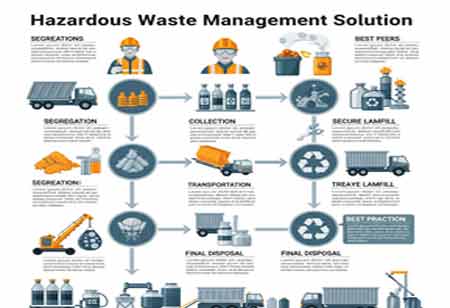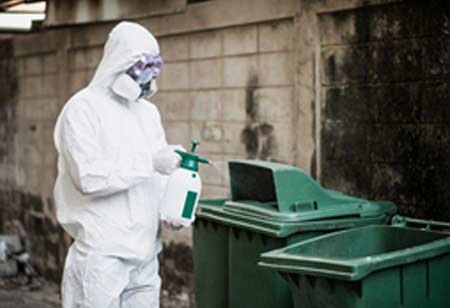Thank you for Subscribing to Environmental Business Review Weekly Brief
Advancing Safety: Innovations in Hazardous Waste Management
Organizations that use intelligent hazardous waste management systems are better equipped to meet ESG standards and enhance resilience against environmental risks.

By
Environmental Business Review | Wednesday, October 08, 2025
Stay ahead of the industry with exclusive feature stories on the top companies, expert insights and the latest news delivered straight to your inbox. Subscribe today.
The demand for effective hazardous waste management solutions is intensifying globally, driven by stringent environmental regulations, industrial growth, and growing public health concerns. Hazardous waste is a byproduct of sectors such as chemicals, pharmaceuticals, mining, oil and gas, and electronics manufacturing, posing significant risks if not managed properly. The rules, shaped by global conventions like the Basel Convention and regional laws, are powerful catalysts for adopting advanced waste management solutions.
Public-private partnerships can help finance large-scale treatment plants, mobile waste treatment units, and recycling technologies that support resource recovery. Cloud-based systems reduce the need for upfront infrastructure investments while enabling remote access and collaboration. Open data standards and APIs are being developed to improve platform interoperability, enhancing visibility and accountability throughout the waste supply chain. Improving efficiency, safety, and compliance helps reduce environmental liabilities, lower operational costs, and improve corporate reputation.
Market Factors and the Push Toward Sustainability
Several other market factors also fuel this growth. Rising urbanization and industrialization lead to increased generation of hazardous waste in both urban and rural areas. Public awareness around pollution, toxicity, and ecological degradation has amplified the pressure on companies to operate sustainably and transparently. Investors and stakeholders now demand visible ESG (Environmental, Social, and Governance) compliance, further driving organizations to integrate responsible waste practices into their operations. Incidents such as toxic leaks, improper landfill use, and illegal dumping have posed reputational and financial risks, compelling businesses to partner with professional hazardous waste management solutions.
Another significant influence is the shift toward a circular economy, which emphasizes resource recovery and reducing landfill dependency. Organizations are rethinking waste treatment models by seeking waste-to-energy conversion, chemical recycling, and material recovery opportunities. The goals demand sophisticated waste categorization, segregation, tracking, and treatment capabilities, which require advanced technologies and integrated management systems. The hazardous waste management sector is transitioning from reactive disposal services to proactive, data-centric, and sustainability-driven solutions.
Technological Trends and Transformative Applications
AI revolutionizes hazardous waste management by enabling smarter, safer, and more efficient operations. The systems can distinguish between flammable, corrosive, reactive, and toxic substances, ensuring appropriate handling protocols are followed throughout the waste lifecycle. AI-enabled predictive analytics allows companies to anticipate waste generation trends based on historical production data and seasonal patterns. Real-time tracking of waste shipments, combined with geospatial analysis, ensures accountability and reduces the risk of environmental incidents.
Another transformative trend is the use of robotics and automation in hazardous waste handling. Drones and robotic arms equipped with sensors detect leaks, handle hazardous materials, and operate in high-risk areas, thereby minimizing human exposure. In treatment facilities, automated sorting machines use AI to separate waste streams, improving processing speed and accuracy. ML models help monitor equipment health, predict failures, and maintain safe working conditions in incineration, chemical treatment, and containment units.
Digital platforms and cloud-based hazardous waste management systems are gaining momentum. The platforms enable real-time data collection, remote monitoring, compliance reporting, and stakeholder communication. IoT-enabled waste bins and containers transmit data on fill levels, temperature changes, and hazardous reactions, triggering timely interventions. Combined with blockchain, these systems provide transparent and tamper-proof audit trails for waste handling, which are particularly valuable in industries subject to strict regulatory scrutiny, such as pharmaceuticals and nuclear energy.
The technologies have applications across the entire hazardous waste management cycle—from on-site waste generation to off-site transportation, treatment, recycling, and final disposal. AI also supports environmental risk modeling by simulating potential hazards and assessing the ecological impact of various treatment options. In public sector applications, AI-driven platforms are helping municipal authorities detect illegal dumping sites, monitor air and soil quality around waste zones, and make policy decisions based on real-time environmental data.
Market Impact and Future Imperatives
Poor waste segregation practices, lack of specialized treatment facilities, and limited regulatory enforcement often lead to unsafe disposal methods, putting the environment and public health at risk. Hazardous waste typically contains a mixture of materials with varying chemical properties, making it challenging to treat or recycle using standard processes. Emerging contaminants and microplastics further complicate treatment efforts. Data silos across government agencies, industrial operators, and waste handlers create barriers to effective collaboration, tracking, and policy enforcement.
Governments and regulators must invest in upgrading waste management infrastructure, establishing clear disposal protocols, and enforcing compliance through digital tracking systems. The need for such solutions is becoming increasingly urgent as industries expand and environmental regulations become more stringent. Data-driven, AI-enhanced, and sustainably designed hazardous waste management solutions are operational necessities and strategic imperatives.
Global markets move toward greener and safer industrial ecosystems, and hazardous waste management will be a cornerstone of environmental governance, industrial responsibility, and sustainable development. The future of dangerous waste management lies in advanced systems that combine regulatory knowledge, real-time data, and predictive capabilities to prevent risks before they arise. As organizations embrace this transformation, they will reduce their ecological footprint and build long-term value through operational excellence and societal trust.





